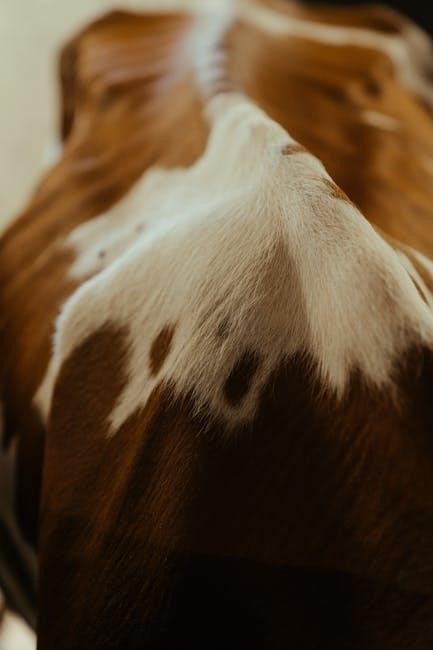External Anatomy of Cattle: A Comprehensive Guide
This guide provides a detailed overview of bovine external anatomy.
It encompasses key body regions and specific parts.
Understanding the exterior structure is essential for animal care.
It’s also crucial for effective livestock management practices.
The external anatomy of cattle encompasses all the visible parts of a cow, from its head to its tail.
Understanding these external features is crucial for anyone involved in animal husbandry, veterinary medicine, or agricultural education.
This comprehensive guide offers a detailed exploration of the various external body parts of cattle.
It includes a labeled diagram for easy identification.
We will cover regions such as the head, neck, body/barrel, forequarters, and hindquarters.
Each section will describe the prominent features within that area.
Specific body parts like the mouth, horns, udder, and teats will be thoroughly examined.
This knowledge aids in assessing animal health, identifying breeds, and understanding physical characteristics.
The external anatomy also provides insights into the animal’s overall well-being and productivity.
Whether you’re a student, farmer, or animal enthusiast, this guide serves as a valuable resource.
It enhances your understanding of the fascinating world of bovine anatomy.
We aim to provide clear explanations and visual aids to facilitate learning and retention.

Regions of the Body
Cattle’s external anatomy can be divided into five main regions.
These include the head, neck, body/barrel, forequarters, and hindquarters.
Each region has distinct characteristics.
These characteristics contribute to the animal’s overall structure.
Head Features
The head of cattle presents several important external features.
The mouth, an organ of prehension, includes lips, tongue, and teeth.
Also included is the dental pad.
Horns, when present, vary in size and shape across breeds.
The poll is the topmost part of the head between the ears.
The face extends from below the eyes to the muzzle.
The forehead is located above the eyes.
Eyes can be flat, dishy, or bulging.
The muzzle encompasses the nose and mouth area.
Ears vary in size and shape depending on the breed.
Each feature contributes to the animal’s sensory perception.
They also aid in feeding and overall well-being.
Breed standards often emphasize specific head characteristics.
Understanding these details is crucial for animal identification.
It also aids in assessing the animal’s overall health and condition.
Observing head features provides insight into an animal’s breed.
It also provides insight into its potential productivity traits.

Neck Anatomy
The neck of cattle is an essential anatomical region.
It connects the head to the body.
The neck supports the head and allows for movement.
The crest is the upper curve of the neck.
It is more prominent in bulls than in cows.
The dewlap is a fold of loose skin.
It hangs beneath the neck.
The dewlap’s size varies among breeds.
The neck’s length and thickness also differ.
These differences depend on breed and sex.
The jugular groove runs along the side of the neck.
It is an important site for injections.
The neck muscles facilitate head movement and posture.
Palpation of the neck can reveal abnormalities.
These abnormalities can indicate health issues.
Assessing neck conformation is important in breed evaluations.
A well-proportioned neck enhances the animal’s overall appearance.
It is also indicative of good muscular development.
Understanding neck anatomy is crucial for proper animal handling.
Body/Barrel Characteristics
The body or barrel of cattle refers to the trunk region.
It extends from the shoulders to the pelvic area.
The barrel houses vital organs.
These include the heart, lungs, and digestive system.
Ribs form the framework of the barrel.
The back runs along the top of the barrel.
It should be straight and strong.
The loin is the section between the ribs and the hip.
It contributes to meat yield and structural soundness.
The belly is the underside of the barrel.
Its shape indicates digestive capacity.
The flank connects the belly to the hindquarters.
The barrel’s circumference is an indicator of overall size.
A deep and wide barrel is desirable.
It suggests good health and productivity.
The shape of the barrel varies among breeds.
It also depends on the animal’s stage of life.
Assessing the barrel is important for evaluating cattle.
It is also crucial for determining their market value.
Conformation of the barrel is essential for structural integrity.
Understanding the barrel is crucial for animal management.
Forequarters Structure
The forequarters of cattle include the shoulders, chest, and front legs.
The shoulders provide attachment for the front legs.
A well-muscled shoulder indicates good meat yield.
The chest is located at the front of the barrel.
It houses the heart and lungs.
Chest depth is important for respiratory function.
The brisket is the projecting part of the chest.
It is located between the front legs.
The front legs consist of the upper arm.
The forearm, knee, cannon bone, and pastern are also included.
The knee joint connects the forearm and cannon bone.
The cannon bone is the main bone in the lower leg.
The pastern is the area between the cannon bone and the hoof.
The hoof is the hard, protective covering of the foot.
The dewclaws are small appendages located above the hoof.
Proper leg conformation is essential for movement.
It is also crucial for supporting the animal’s weight.
Strong, straight legs are desirable traits.
They contribute to the animal’s longevity.
The angle of the shoulder affects stride length.
The forequarters play a vital role in the animal’s balance.
Understanding the forequarters is important for proper care.
It is also crucial for evaluating overall conformation.
Hindquarters Composition
The hindquarters of cattle consist of the rump, hips, thighs, and rear legs.
The rump is the area from the loin to the tail head.
A long, wide rump indicates good muscle development.
The hips are the bony prominences on either side of the rump.
They provide attachment for the thigh muscles.
The thighs are located between the hips and the stifle joint.
They contain large muscles important for locomotion.
The stifle joint is equivalent to the human knee.
It connects the thigh and the lower leg.
The gaskin is the muscular area below the stifle.
The hock is the joint between the gaskin and the cannon bone.
The cannon bone is similar to the front legs.
The pastern and hoof are also similar.
The pin bones are located below the tail head.
The tail switch is the brush of hair at the end of the tail.
Proper hindquarter conformation is essential for movement and balance.
It is also important for reproductive function in females.
Strong, well-muscled hindquarters are desirable traits.
They contribute to the animal’s overall value.
The angle of the hock affects the animal’s gait.
The width of the hindquarters is related to pelvic capacity.
Understanding the hindquarters is important for proper care.
It is also crucial for evaluating breeding potential.

Specific External Body Parts
This section details specific external features of cattle.
These include the mouth, horns (when present), and udder.
Understanding these parts is important for animal health.
It also aids in assessing overall well-being.
Mouth and Related Structures
The mouth is a crucial part of the bovine external anatomy.
It is used for prehension, mastication, and initial digestion.
Key components include the lips, tongue, teeth, and dental pad.
The lips are prehensile, aiding in grasping forage.
The tongue assists in manipulating food within the mouth.
Cattle possess a dental pad instead of upper incisors.
This pad works with the lower incisors to tear vegetation.
The jaw facilitates chewing, grinding plant matter.
Saliva production is essential for lubrication and enzymatic breakdown.
The muzzle, or nose, is located just above the mouth.
It contains nostrils for respiration and sensory perception.
The overall structure of the mouth is adapted.
It is specifically for efficient grazing and rumination.
A healthy mouth is vital for nutrient intake and overall health.
Regular inspection of the mouth can detect early signs.
Detecting early signs of disease and dental problems is important.
Dental problems can significantly impact a cow’s ability.
The ability to feed properly impacts its health and productivity.
Horns (If Applicable)
Horns are prominent features on certain breeds of cattle.
Their presence and characteristics vary significantly.
Horns are composed of a bony core covered by keratin.
Keratin is a tough protein material, similar to human fingernails.
The shape, size, and curvature of horns are breed-specific.
Some breeds are naturally polled, meaning they lack horns.
Others are dehorned at a young age for safety reasons.
Horns serve various purposes, including defense.
They also help establish social hierarchy within a herd.
The horn’s base is attached to the frontal bone of the skull.
Blood vessels and nerves supply the horns with sensation.
Rings can sometimes be observed on the horn’s surface.
These rings may indicate periods of stress or changes.
Changes in growth rate in the animal’s life can cause this.
The color of horns can vary from black to yellowish-white.
This depends on the breed and the animal’s age.
Proper management of horned cattle is crucial.
It reduces the risk of injury to other animals and handlers.
Dehorning, when practiced, should be performed humanely.
This minimises stress and pain for the animal involved.
Udder and Teats
The udder is a crucial external feature of female cattle.
It is the milk-producing gland located in the inguinal region.
The udder’s size and shape vary depending on breed and lactation stage.
It is supported by ligaments, which provide structural integrity.
The udder is divided into four distinct mammary glands.
Each gland independently produces and stores milk.
Teats are the external openings of each mammary gland.
They are the structures through which milk is released during milking.
The size and shape of teats also vary among breeds.
Proper teat conformation is important for efficient milking.
Teats should be of adequate size and evenly spaced.
This allows for proper attachment of milking equipment.
The skin of the udder and teats should be healthy and free.
It should be free of lesions or infections.
Mastitis, an inflammation of the mammary gland, is a common concern.
Regular inspection of the udder and teats is essential.
This is to detect early signs of infection or abnormalities.
Proper hygiene during milking is crucial.
It helps prevent the spread of mastitis-causing organisms.
The udder and teats are vital indicators of a cow’s health.
They are also important indicators of milk production potential.

Importance of Understanding External Anatomy
Understanding the external anatomy of cattle is paramount.
It is fundamental for effective animal management and care.
Knowledge of external features aids in identifying breeds.
It also helps to assess overall health and well-being.
Observing the coat condition and body conformation can reveal nutritional status.
It can also reveal potential health problems.
Recognizing abnormalities in body parts is crucial for early detection.
Early detection of diseases can prevent diseases and allow for timely intervention.
Understanding the location of specific anatomical landmarks is essential.
Essential for administering medications and performing procedures.
For instance, knowing the location of injection sites minimizes tissue damage.
Knowledge of external anatomy enhances breeding practices.
It helps in selecting animals with desirable traits.
This contributes to improving herd quality and productivity.
Understanding udder conformation is vital for dairy farmers.
It helps select cows with high milk production potential.
Assessing hoof health is essential for preventing lameness.
Lameness is a major cause of economic loss in cattle production.
Familiarity with external anatomy improves communication.
It improves communication between farmers and veterinarians.
Accurate descriptions of physical signs facilitate diagnosis.
Ultimately, understanding external anatomy leads to better animal welfare.
It also leads to increased efficiency in cattle management.





